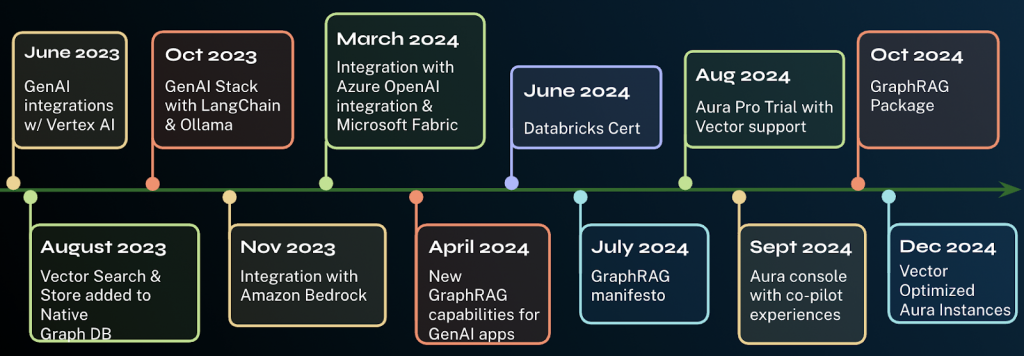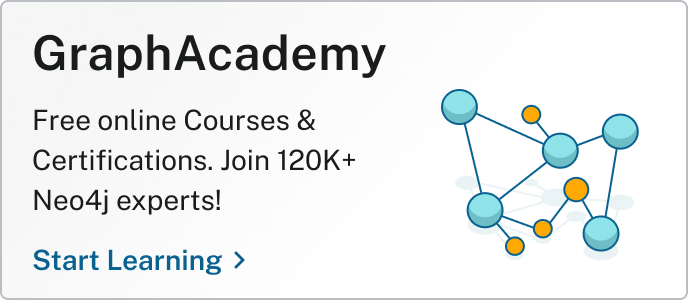
We’re thrilled to share that Sudhir Hasbe has been promoted to President of Technology & CPO at Neo4j. In his two and a half years at Neo4j, Sudhir has helped make Neo4j essential to the modern tech stack: accelerating product innovation, scaling our cloud platform, bringing graph analytics to every data platform, and enabling real-world GenAI systems for customers around the world. Under his leadership, Neo4j has become the most comprehensive cloud-native graph database and analytics offering on the market. As organizations shift toward agentic AI, graph technology will serve as the heartbeat.
Sudhir will lead Neo4j’s technology vision and execution across database, cloud, ecosystem, developer experience, and AI infrastructure. As President of Technology & CPO, he drives the product strategy and roadmap while overseeing technical go-to-market, field engineering, developer relations, product marketing, communications, corporate development, and our technology ecosystem strategy to ensure customer success.
Turning Vision Into Execution
Sudhir joined Neo4j with a clear goal: bring the power of graph to every organization and developer. That vision has shaped how we build, how we listen to our users, and how we innovate at scale.
Under Sudhir’s leadership, our focus spans four pillars:
- Trusted Fundamentals: Advancing our core graph database capabilities for better performance, security, and scale
- Cloud First: Delivering a fully managed zero-ops experience through AuraDB and Aura Analytics
- Ease of Use: Enhancing the developer experience and boosting developer productivity with an evolving set of powerful tools
- Agentic AI: Enabling smarter, safer agentic and GenAI systems built on a connected foundation
Here’s a look at the progress we’ve made in these areas under Sudhir’s leadership—and how we plan to keep pushing the envelope of innovation in 2026 and beyond.
Built for Scale, Performance, and Trust
Our core database continues to evolve for the world’s most demanding use cases:
- Block storage format marks a key advance in graph-native storage architecture. By grouping related graph data into optimized blocks, we’ve dramatically reduced I/O operations and accelerated property access.
- Parallel runtime capability enhances performance for large analytical queries by efficiently using multiple CPU cores. Dividing the workload into multiple threads enables faster traversal of substantial portions of the graph, optimizing the use of available system resources and accelerating queries.
- Change data capture (CDC) delivers production-ready capabilities for real-time change tracking through our transaction log architecture. Available in both full and differential capture modes and integrated with Apache Kafka and Confluent Cloud, CDC opens new possibilities for event-driven architectures.
- CALL in Transactions (CIT) enables transactional logic to run within database transactions—providing improved performance and greater flexibility for developers.
- Sharded Database to support 100TB graph databases. This feature is now in EAP.
These enhancements are more than just technical milestones. They’re helping customers scale faster, achieve deeper insights, and trust their systems in production.
From Cloud Hosted to Cloud Native: Delivering Zero-Ops Graph
AuraDB, our fully managed cloud offering, is now trusted by organizations of every size and growing stronger every quarter. Today, AuraDB powers over 30,000 active graph databases across AWS, Azure, and Google Cloud Platform—marking a significant milestone in our cloud-first journey.
We also listened to our customers carefully, and many of our improvements came directly from their feedback:
- Enterprise security and compliance: We shipped many features, including fine-grained access control, Single Sign-On (SSO), Multi-Factor Authentication (MFA), encryption at rest and in transit, customer-managed keys (CMEK), private link, advanced observability and access controls, and multiple compliance certifications, including HIPAA and SOC 2 Type 2.
- Cost savings: We introduced a free trial for AuraDB Professional and a Business Critical tier, which offers enterprise features at 25-percent lower cost to better serve scaling teams.
- Scalability on demand: With read-only secondaries, customers can now horizontally scale their AuraDB instances by distributing read-heavy workloads across up to 15 secondaries.
- Serverless graph analytics: A dedicated serverless offering that allows Aura users to go beyond traditional analytics by running 65+ advanced graph algorithms—with data from any source.
Our partnerships with AWS, Azure, and Google Cloud are central to our cloud strategy. Neo4j was named Google Cloud Partner of the Year for data management, and we’ve launched native integrations with Vertex AI, Azure OpenAI, Microsoft Fabric, Databricks, and Snowflake—meeting developers where they already work.
Simplifying the Developer Journey
Sudhir’s product vision centers around one idea: Make graphs accessible to every developer, and go from signup to success in record time. He calls it the “5-5-5” experience: 5 seconds to sign up, 5 minutes to wow with your data, and 5 days to see real business value. These improvements have fueled our product-led growth, with over 80-percent year-over-year growth in cloud consumption.
At the heart of this shift is our new Aura Console, a unified environment for data modeling, visualization, and management. It enables teams to collaborate more effectively while maintaining secure access through expanded roles and controls. Developers can find everything they need in one place.
We’ve also introduced AI-assisted tooling, including AI-powered graph data modeling, GenAI copilot to generate and explain queries, AI-powered dashboards, and developer APIs that enable database access over HTTPS and offer command-line management capabilities for simplified data import. We also introduced MCP Servers, now in production with multiple customers, which provide powerful orchestration capabilities and improved server-side performance. Developers can now interact with Neo4j using a broader set of interfaces, including GraphQL and HTTP APIs, along with our core language drivers.
As mentioned earlier, we’ve developed an integrated data ecosystem across the cloud platforms our customers depend on. Our collaboration with Microsoft brought Neo4j capabilities into its Fabric analytics platform and Azure OpenAI Service. Our Databricks connector has been validated as a partner solution for seamless integration. And customers in the Snowflake AI Data Cloud can now run 65+ graph analytics algorithms on the Snowflake container service using just three lines of SQL.
Accelerating AI Innovation With GraphRAG
GraphRAG has become a critical tool for accelerating GenAI application development. Combining knowledge graphs and retrieval-augmented generation (RAG), GraphRAG dramatically improves the reliability and accuracy of GenAI responses. Gartner analysts have identified it as a “high-impact” technology for its ability to “significantly improve the contextual relevance and accuracy of GenAI applications.”
Under Sudhir’s leadership, we’ve built on this momentum by delivering a comprehensive suite of tools to help organizations implement GraphRAG. These include an open-source Text2Cypher model, Python SDK, LangChain plugin, LLM Graph Builder, and our GraphRAG Python package, which allows developers to build knowledge graphs from unstructured data and use multiple retrieval strategies.
We’ve also created an extensive ecosystem of GenAI tools. We integrate with all LLM platforms (OpenAI, Azure, AWS, Google Cloud Platform, etc.) and support major frameworks like LangChain, LlamaIndex, Haystack, and Spring AI.
The diagram below captures the recent drumbeat of AI innovation at Neo4j:

Laying the Foundation for Agentic AI
Organizations are moving beyond GenAI experimentation into real systems, and the conversation is shifting from isolated prompts to persistent memory, reasoning, decision traceability, and intelligence that can power the next generation of GenAI apps.
We’re making it easy for developers to build intelligent agents by providing a comprehensive platform for modeling, managing, and retrieving context. We’re building more capabilities in development to support agents who not only retrieve but reason, act, and evolve. Graph is the only architecture that gives them the grounding and structure that they need.
It’s exciting to help customers shift from experimental GenAI to intelligent systems that operate at scale, in production, and shape an agentic future. Sudhir’s leadership, under the broader vision of our Founder and CEO, Emil Eifrem, is enabling us to shape the GenAI area. This is just the beginning.









